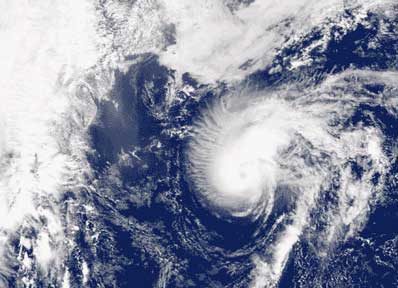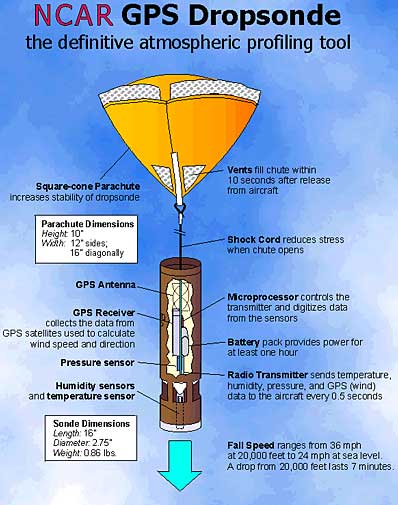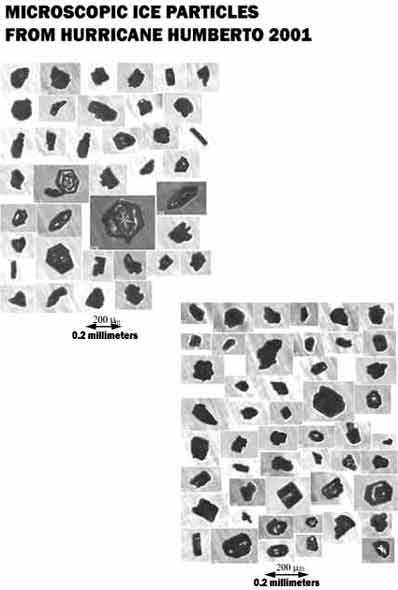
Tiny particles in hurricanes may help with predictions
NASA-GODDARD NEWS RELEASE
Posted: April 30, 2002
NASA-funded scientists are looking at microscopic ice particles inside hurricanes to determine if they contribute to the storm's strengthening or weakening. Researchers have discovered that greater numbers of ice particles higher up in a hurricane reflect more energy from the Sun out to space, creating a temperature difference that helps power the hurricane. The particles could also indicate a loss of energy into the surrounding atmosphere.

Hurricane Humberto spiraled just north of Bermuda on September 24, 2001. CAMEX-4 scientists took extensive measurements of Humberto using NASA's high altitude ER-2 aircraft and a special downward looking radar, called ER-2 Doppler Radar (EDOP). The true-color image was acquired by the Sea-viewing Wide Field-of-view Sensor (SeaWiFS). Credit: SeaWiFS
|
During a flight into Hurricane Humberto in 2001, researchers identified a large number of ice particles up to 7 millimeters in diameter in the upper reaches of the storm, around 39,000 feet high. The research was part of CAMEX-4 (The Convection And Moisture EXperiment), a joint effort between NASA, the National Oceanic and Atmospheric Administration (NOAA) and a number of universities.
"We've found that a high concentration of small particles at the top portion of a hurricane are very reflective, and they send more energy back to space than previously thought," said Andrew J. Heymsfield, researcher from the National Center for Atmospheric Research (NCAR), Boulder, Colo., and a lead author on a paper on the experiment.

A dropsonde is a sensor that measures temperature, pressure, wind and humidity of the atmosphere. The sensor is attached to a parachute and is dropped from an aircraft over a given area, and transmits data every one-half of a second back to the aircraft that dropped it. Credit: National Center for Atmospheric Research (NCAR)
|
Large concentrations of small ice crystals can reflect more sunlight and can lead to strong cooling near the tops of hurricanes, creating more of a temperature contrast between the bottom and top of the storm. That contrast of air temperatures could possibly contribute to its strength, just as a cold front moving into warm, moist air triggers thunderstorms.
"Updrafts of wind in hurricanes are generally pretty small, so some researchers did not expect large (up to 7 millimeters) particles, which generally form at warm temperatures, to exist at higher altitudes," Heymsfield said. Because large particles weigh more, they fall faster than small particles, and small particles can evaporate.
Aaron R. Bansemer, co-author on the paper and on the experiment noted that the data from Humberto showed some of the larger particles were transported to at least 35,000 feet, or may have grown to large sizes through aggregation of smaller particles, a process that is usually thought to occur at warmer temperatures, usually around 18,000 feet.

This is a picture of smaller ice crystal particles found at an altitude of 39,000 feet during a flight into Hurricane Humberto in 2001. These were imaged by the CPI (Cloud Particle Imager) is the high-resolution probe onboard NASA's ER-2 aircraft. The scale (200um) is in micrometers, equivalent to 0.2 millimeters. Larger particles are not depicted in this image. Researchers identified a large number of ice particles up to 7 millimeters in diameter in the upper reaches of the storm, accounting for why a hurricane is so reflective. Ice crystals reflect more sunlight and can lead to strong cooling near the tops of hurricanes, creating more of a temperature contrast between the warm storm and the cooler air surrounding it.
|
Scientists are curious about how ice particles and condensed water is distributed in a hurricane because it tells them where most of the mass or 'weight' is in a hurricane. Knowing this distribution of mass will help researchers determine if a hurricane is strengthening. If most of the hurricane's mass (condensed water and ice particles) is high in the storm, some may escape into other parts of the upper troposphere where it evaporates, weakening it by reducing the overall precipitation efficiency of the hurricane.
This discovery and observations of particles higher up in hurricanes are being entered into computer models that simulate hurricanes, and will give researchers a better idea of the workings of hurricanes. "The bottom line here is that by identifying where larger ice particles are in a hurricane, we are adding to the data we put in computer models simulating the storms, and that will improve predictions on whether a hurricane is strengthening or weakening," Heymsfield said.
This paper, "In Situ Measurements of Particle Size Distributions in Hurricane Humberto," were presented on Monday, April 29, 2002, at the American Meteorological Society Hurricane and Tropical Meteorology Conference, San Diego, Calif.
This research was entirely funded by NASA through the CAMEX-4 Mission.

|
 |
 |
 |









|

